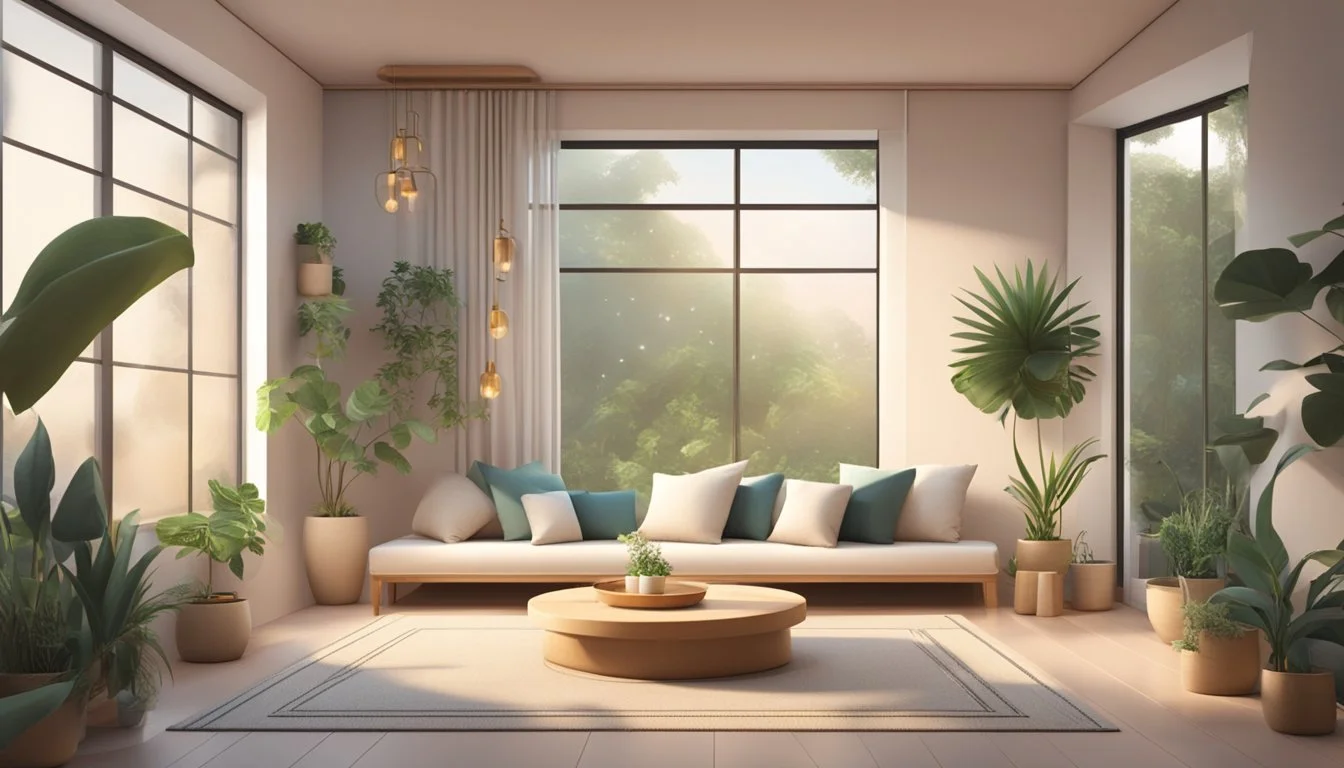Free Land for Meditation Centers
How to Secure and Utilize Space for Tranquil Retreats
Imagine transforming a vacant plot of land into a serene meditation center that soothes the mind, body, and spirit. This is not just an idealistic dream; opportunities exist where land is granted for free to build meditation centers dedicated to peace and tranquility. By utilizing these spaces, you can create a natural retreat that fosters meditation and well-being at no cost for the land.
Natural elements such as plants, water features, and pathways play a crucial role in creating a peaceful environment. Incorporating these elements can enhance the sensory experience of meditation, bringing a deeper sense of calm and connection to the natural world. A well-designed meditation garden can provide a sanctuary where individuals can retreat from the stresses of everyday life.
Building a meditation center on free land involves thoughtful planning and design to create an inviting and tranquil space. From selecting the ideal location to incorporating personal touches, the focus is on creating an environment that makes it easier for people to find peace and serenity. This opportunity allows for the establishment of dedicated spaces that nurture the spirit and promote overall well-being.
The Importance of Meditation Spaces
Meditation spaces play a vital role in fostering mindfulness and clarity. These environments provide an ideal setting for individuals to connect with their inner peace and engage deeply with meditation practice.
Connecting Mind, Body, and Spirit
Meditation spaces are designed to create a harmonious atmosphere that promotes the unity of mind, body, and spirit. Such spaces are often secluded to assure privacy and intimacy, allowing practitioners to fully immerse themselves in their meditation practice without disruption.
The architecture and design of these spaces often employ minimalist elements that enhance focus and remove distractions. By providing an environment conducive to contemplation, individuals can achieve deeper levels of mindfulness and clarity, leading to a profound sense of inner peace.
Personal touches and carefully chosen decor can further facilitate this connection, making the space resonate more deeply with those who use it.
The Role of Nature in Meditation
Integrating natural elements into meditation spaces significantly enhances the meditation experience. Elements such as greenery, water features, and natural light help create a soothing ambiance that promotes relaxation and introspection.
Gardens and other outdoor meditation spaces are particularly effective in establishing a connection with nature. The presence of plants, water elements, and natural pathways not only enrich the aesthetic appeal but also contribute to a sense of tranquility.
Nature has an inherent ability to reduce stress and foster mental well-being. Hence, designing meditation areas with a focus on natural components can help individuals achieve a deeper state of mindfulness and inner peace, making these spaces invaluable for meditation practice.
Designing Meditation Centers
Meditation centers should integrate natural elements such as light and greenery, ensure privacy and seclusion, and be designed with comfort and flow in mind.
Incorporating Natural Light and Elements
Natural light plays a crucial role in creating a tranquil atmosphere. Large windows and skylights can maximize the intake of natural light, enhancing the sense of calm and connection to the environment. Additionally, incorporating elements such as trees and flowing water can further elevate the serene ambiance. Strategically placed trees can provide shading and a connection to nature, while water features can introduce soothing sounds. Choosing plants that engage all five senses can transform the space into a true oasis.
Creating a Sense of Privacy and Seclusion
Privacy is essential to foster a deep sense of meditation and reflection. High walls, tall hedges, and well-placed trees can create a secluded retreat. Using materials such as bamboo or wooden slats can provide both privacy and an aesthetically pleasing barrier. The layout should minimize distractions and promote a sense of isolation from the outside world. Positioning the meditation areas away from busy paths and noise sources helps cultivate intimacy and focus.
Functional Considerations for Comfort and Flow
Comfortable seating and a thoughtful layout contribute significantly to the functionality of a meditation center. Seating options should include cushions, mats, or ergonomic chairs that can accommodate long meditation sessions. The design should facilitate smooth flow, allowing easy movement between different areas. Pathways should be clear and well-marked, guiding visitors intuitively through the space. Incorporating natural elements such as stone pathways and wooden decks can enhance the overall experience. Attention to these details ensures that the space is both inviting and practical for meditation.
Outdoor Meditation Gardens
Creating a peaceful and inviting outdoor meditation garden involves selecting appropriate vegetation, designing thoughtful paths and water features, and incorporating stones and aesthetic touches to enhance the space.
Selecting the Right Vegetation
Choosing the right plants is crucial for creating a serene atmosphere. Greenery such as bamboo, ferns, and moss can promote a calming environment. Fragrant flowers like lavender and jasmine can provide soothing aromas, enhancing the meditative experience. Including edible plants like mint or basil can engage the sense of taste, while colorful blooms and interesting textures stimulate the visual senses. It's essential to choose low-maintenance plants to ensure the garden remains a peaceful retreat year-round.
Designing Paths and Water Features
Paths and water features play a significant role in guiding the flow of the garden and elevating its tranquil feel. Opt for natural stone or gravel paths to lead visitors through the garden gently. Adding a pond, fountain, or small waterfall can introduce calming water sounds, which are vital for aiding meditation. Paths arranged in a winding or circular pattern can encourage contemplation and mindfulness, while strategically placed benches along the way provide spots for rest and reflection.
Incorporating Stones and Aesthetic Touches
Stones and other aesthetic elements help to personalize the meditation garden and enrich the overall ambiance. Utilize large stones or rock formations to create focal points. Small, smooth pebbles can be used in pathways or as decorative elements around plants. Consider placing statues, such as Buddha figures, to add a spiritual touch. Benches and art pieces made from natural materials like wood or stone can further enhance the garden’s aesthetic appeal, creating a harmonious and inviting space for meditation.
Indoor Meditation Areas
Creating indoor meditation areas involves optimizing lighting and acoustics to foster calm and choosing furnishings and decor that enhance peace and aesthetics.
Optimizing Lighting and Acoustics
Lighting is critical to the ambiance of indoor meditation spaces. Utilizing natural light can enhance the meditative experience, making spaces near windows ideal. Soft, diffused lighting from lamps or candles can substitute when natural light is insufficient. Avoid harsh, overhead lights as they can be distracting.
Acoustics also play a significant role. Incorporate soundproofing materials such as thick curtains, rugs, and acoustic panels to minimize external noise. Adding a small water fountain can create a soothing background sound. Ensure any white noise machines are set to calming sounds like rain or gentle breezes to maintain a tranquil environment.
Choosing Appropriate Furnishings and Decor
Select furnishings that are both functional and contribute to an aesthetic that promotes peace and calm. Meditation cushions or zafus provide comfort and support. Low-profile furniture like futons or floor cushions can help maintain a grounded feel.
Decorate with potted plants to bring a touch of nature indoors, enhancing tranquility. A woven pouf or faux fur rug can add texture, making the space more inviting. Use neutral colors and avoid clutter to keep the area peaceful and focused on meditation. Including elements like a small ladder shelf can also add a practical and serene touch.
Elements of a Tranquil Meditation Space
Creating a tranquil meditation space involves harnessing natural elements to engage the senses and balancing aesthetics with functionality to foster calmness and reflection.
Sensory Experience and the Influence of Nature
Engaging the senses is essential for a meditation space. Natural elements like greenery, water, and wood can create a calming environment. Lavender and other aromatic plants enhance this effect by providing soothing scents that promote relaxation.
Water elements such as ponds or fountains generate gentle sounds, adding to the peaceful atmosphere. Similarly, gentle breezes through trees and the gentle rustle of leaves can further enhance the sensory experience, fostering a sense of tranquility.
Incorporating these elements helps to create a multi-sensory environment that supports mindfulness practices.
Balancing Aesthetics and Functionality
A successful meditation space balances aesthetic appeal with practical use. Simplicity in design is crucial, often seen in Japanese Zen gardens. Carefully arranged elements like stones, plants, and seating areas should serve both visual and functional purposes.
Paths made from natural materials like wood enhance the space's beauty and guide movement thoughtfully. Seating can vary from simple wooden benches to more elaborate arrangements, as long as it fits seamlessly into the environment.
When aesthetics and functionality are harmonized, the space becomes more inviting and effective for meditation, promoting sustained mental well-being and calm.
Meditation Center Layout and Construction
Designing a meditation center involves careful planning and thoughtful placement, ensuring spaces are both flexible and inclusive. Paths, seating arrangements, and accessibility should all be meticulously considered to create a tranquil and welcoming environment.
Planning for Flexibility and Multiple Uses
Meditation centers should be designed with flexibility in mind to accommodate various activities. Modular spaces and movable partitions can be used to transform areas based on need.
Paths and walkways, whether straight or curved, should guide individuals naturally while preserving a sense of peace. Gravel pathways, for instance, add a tactile and auditory dimension, enhancing the meditative experience.
Height variations in the building design can also enrich the spatial experience, allowing for lofted contemplation areas or more intimate, lower-ceilinged rooms.
Seating arrangements should be adaptable, providing options from floor cushions to chairs, depending on the type of meditation or group activity. This adaptability can accommodate individual preferences and ensure comfort for all users.
Ensuring Accessibility and Inclusivity
Accessibility is crucial in meditation center design to ensure everyone can benefit from the space. Entrances and paths must be wide, barrier-free, and compliant with accessibility standards such as the ADA.
Inclusion of ramps instead of steps and the use of elevators for multi-level centers make the space accessible to individuals with mobility issues. Clearly marked, unobstructed paths enhance navigation.
Incorporating quiet areas with soft seating arrangements can cater to those needing more sensory-friendly environments. The placement of these areas should consider natural light and sound insulation to maintain a calm atmosphere.
Bathroom facilities should be designed to accommodate various abilities, and signage should be clear and legible, aiding those with visual impairments. These actions ensure the meditation center is welcoming to everyone.
Accessorizing the Meditation Space
Creating a meditation space involves more than just selecting a location; it requires thoughtful accessorizing to enhance reflection and maintain a clean, inviting environment. Each element should contribute to a serene atmosphere that promotes tranquility and introspection.
Selecting Features to Enhance Reflection and Introspection
Incorporate natural elements like water features or stones. A small pond or fountain can produce soothing sounds that enhance the meditative experience. Adding plants and greenery helps to foster a connection with nature. Use materials like wood and stone to create pathways and seating areas.
Candles, essential oil diffusers, and incense are valuable additions for creating a tranquil atmosphere through scent. Consider interactive elements like a Zen garden with pebbles or sand for tactile meditation. Wind chimes can also contribute to a peaceful ambiance with gentle, melodic sounds.
Maintenance of a Clean and Inviting Environment
Ensure the area is free of clutter. Regular cleaning is vital to keep the space inviting and maintain its intended purpose. This includes removing leaves, debris, and any distractions that may accumulate over time.
Focus on simple, clean designs that do not overwhelm the senses. Minimalist furniture and neatly arranged paths can prevent feelings of congestion. Keep seating options like mats or benches clean and in good condition.
Regularly tend to the plants and greenery to keep them healthy and vibrant. Maintain water features to prevent stagnation, ensuring the space remains fresh.
Integrating Meditation Into Daily Life
Creating a dedicated meditation space in everyday settings can help foster mindfulness and promote a consistent meditation practice. By taking small steps to integrate meditation into daily life, individuals can cultivate a sense of tranquility and mental clarity.
Making Space for Meditation in Everyday Settings
Creating a dedicated meditation space at home can significantly enhance one's practice. This space doesn't need to be large; a small corner or a special room with minimal distractions works well. Adding elements like cushions, plants, or even a small gazebo in the garden can create a serene environment.
Outdoor meditation spaces can be just as effective. Nature provides a calming backdrop, and elements such as water features or wind chimes can enhance the experience. Including natural elements helps ground the practice, making it a peaceful part of one's day-to-day life.
Promoting Continual Practice and Mindfulness
To maintain a daily meditation practice, integrating brief sessions throughout the day is essential. Starting the day with a 5-minute session and incorporating mid-work meditation breaks can help manage stress and improve focus.
Mindfulness can be practiced outside formal meditation sessions. Simple activities like focusing on breath, mindful walking, or even slowing down during routine tasks can lead to a more mindful lifestyle. Consistency is key; setting reminders or using apps can support regular practice and help integrate meditation seamlessly into modern life.







